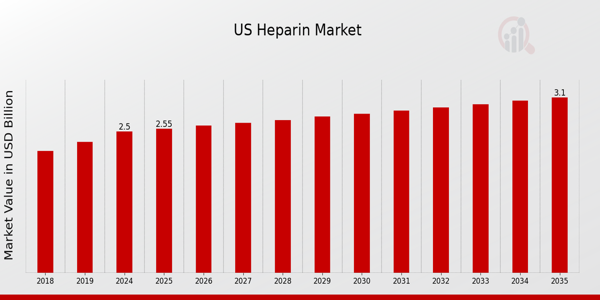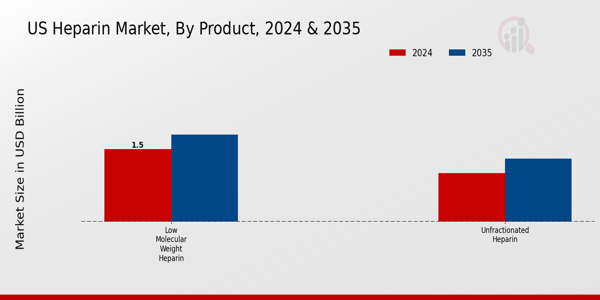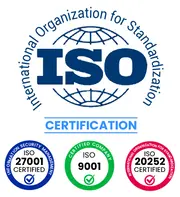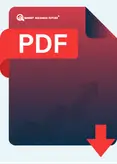US Heparin Market Overview
As per MRFR analysis, the US Heparin Market Size was estimated at 2.02 (USD Billion) in 2023. The US Heparin Market Industry is expected to grow from 2.5 (USD Billion) in 2024 to 3.1 (USD Billion) by 2035. The US Heparin Market CAGR (growth rate) is expected to be around 1.975% during the forecast period (2025 - 2035).
Key US Heparin Market Trends Highlighted
The US Heparin Market is observing noteworthy developments resulting from the sharp rise in the cases of heart diseases and the growing elderly population, both of which increase the market need for anticoagulant treatments. In line with better technologies, producers are concentrating on creating Grade A heparin products that improve safety and efficiency.
Stricter regulatory policies are encouraging companies to adopt better quality control procedures during the cracking production process. Additionally, due to the continuous attempt to mitigate the risk associated with heparin, hospitals and other healthcare facilities are adopting better patient dosing and monitoring techniques.
Surgical procedures that necessitate anticoagulation therapy, and an increasing number of patients suffering from chronic conditions requiring routine heparin management, are two factors creating new opportunities in the US market. Additionally, the increase in Homecare settings is encouraging the demand for easy access to heparin products as patients seek more control over their treatment settings.
Also, collaboration and strategic alliances between pharmaceutical firms and other healthcare enterprises are emerging to expand the marketing and distribution of heparin products. Furthermore, more and more patients are being shifted into and preferring to be treated with Low Molecular Weight Heparins (LMWHs) which has led to an upsurge in demand for such products due to their benefits relative to Unfractionated Heparin, particularly in outpatient facilities.
New treatment options are being explored by researcher’s looking into new delivery systems and formulations. Heparin therapy is going to change significantly with the incorporation of digital health tools and telehealth, giving the patients more efficiency in terms of treatment. These changes are all contributing to the evolving US Heparin Market.

US Heparin Market Drivers
Increase in Cardiovascular Diseases
The prevalence of cardiovascular diseases is a significant driver for the US Heparin Market Industry. According to the Centers for Disease Control and Prevention (CDC), approximately 697,000 Americans die from heart disease each year, accounting for about 1 in every 5 deaths. This high mortality rate creates a persistent demand for anticoagulants, such as heparin, which are critical in managing these conditions.
The American Heart Association has consistently reported the growing prevalence of conditions requiring anticoagulation therapy, leading to a steady growth in the heparin market. With an aging population and lifestyle factors contributing to heart disease, the demand for heparin will continue to flourish as part of treatment protocols.
Growing Surgical Procedures
The increasing number of surgical procedures performed in the United States is another robust driver for the US Heparin Market Industry. The American Hospital Association reports that in 2020, there were approximately 51.4 million total surgical procedures conducted in hospitals, marking a rise from previous years. Heparin is frequently used in various surgeries, especially orthopedic and cardiovascular surgeries, to prevent clot formation during and after procedures.
As the U.S. population ages and the demand for surgical interventions rises, the utilization of heparin is expected to grow correspondingly, thus driving market expansion.
Rising Incidence of Venous Thromboembolism (VTE)
The rising incidence of venous thromboembolism in the United States is a significant factor contributing to the growth of the US Heparin Market Industry. The National Center for Biotechnology Information (NCBI) estimates that VTE affects around 900,000 Americans each year, with approximately 100,000 fatalities. Heparin is a primary line of treatment for VTE, which encompasses deep vein thrombosis and pulmonary embolism.
The high morbidity associated with VTE emphasizes the critical need for effective anticoagulants, spurring growth in the heparin sector as healthcare providers seek to manage this health crisis effectively.
Advancements in Research and Development
Significant advancements in Research and Development (R&D) within the pharmaceutical sector are bolstering the US Heparin Market Industry. Increased funding and focus from organizations like the National Institutes of Health (NIH) have led to novel formulations and improved delivery methods for heparin. The NIH allocated over 41 billion dollars for medical research projects in the United States in 2020, emphasizing the importance of developing more effective anticoagulant therapies.
As innovative heparin products enter the market, healthcare professionals will have a wider range of options, further facilitating market growth.
US Heparin Market Segment Insights
Heparin Market Product Insights
The US Heparin Market is a crucial component in the pharmaceutical landscape, particularly emphasizing its product segment, which includes Unfractionated Heparin (UFH) and Low Molecular Weight Heparin (LMWH). UFH is primarily employed in clinical settings for its rapid anticoagulant action, making it essential for hospital use, especially in managing acute coronary syndromes and during surgeries.
Its ease of administration and effectiveness in preventing thromboembolic complications underpin its importance, contributing to a significant share of treatments administered in both inpatient and outpatient settings. On the other hand, LMWH has gained traction due to its improved pharmacokinetic profiles, enabling once-daily dosing and a reduced risk of side effects, which improves patient compliance.
This segment has established itself as a prevalent choice for long-term anticoagulation therapy, specifically in patients undergoing orthopedic surgeries or in those with a history of venous thromboembolism. The demand for LMWH is bolstered by ongoing clinical research, highlighting its benefits in various therapeutic areas, including oncology and obstetrics.
Amidst evolving healthcare standards and an increasing focus on patient-centered care, the US Heparin Market is influenced by regulatory changes, advancements in formulation technologies, and a growing recognition of personalized medicine approaches. Moreover, the bifurcation of the heparin segment into UFH and LMWH allows for tailored treatment strategies, enhancing therapeutic outcomes.
Overall, these product categories hold significant positions within the US Heparin Market, influenced by clinical efficacy, guidelines from health organizations, and a consistent push towards innovation in anticoagulation therapies. As the market continues to evolve, further research and development in both UFH and LMWH will be pivotal in addressing emerging healthcare challenges, making monitoring of this sector essential for stakeholders.
The understanding of market dynamics and segmentation through product types like UFH and LMWH will guide strategic initiatives and responses to healthcare needs.

Heparin Market Source Insights
The Source segment of the US Heparin Market encompasses critical divisions primarily derived from Bovine and Porcine sources. Bovine-derived heparin has seen notable use due to its effective anticoagulant properties, thereby catering to various medical applications, including surgeries and treatments for thromboembolic disorders. The Porcine market, while also significant, holds a major share owing to its predominant position in the international landscape, being utilized for its reliability and efficacy in therapeutic use.
The heparin sourced from pigs is frequently preferred because of its strong performance in clinical settings. As the focus on health and safety regulations intensifies, both sources are adapting to ensure quality control to meet industry standards while contributing to the overall US Heparin Market Statistics. The growing prevalence of venous thromboembolism (VTE) and an increasing elderly population in the US act as growth drivers for this segment.
However, challenges such as ethical concerns regarding animal sources and potential allergies add complexity to this market segment, urging the industry to explore alternative sources and synthetic heparin options. Overall, the Source segment remains a cornerstone of the US Heparin Market revenue, reflecting ongoing trends in healthcare and biotechnology.
Heparin Market Application Insights
The Application segment of the US Heparin Market reflects a diverse range of medical conditions where heparin plays a critical role as an anticoagulant, particularly in managing cardiovascular and thromboembolic disorders. Deep Vein Thrombosis and Pulmonary Embolism are significant contributors within this segment, as they represent common complications that require immediate medical intervention to prevent severe health outcomes.
Atrial Fibrillation is another key area, where heparin helps to manage stroke risks associated with irregular heartbeats. Conditions like Heart Attacks and Stroke highlight the urgent need for effective anticoagulation therapy, as timely administration of heparin can be life-saving and can minimize long-term complications. Other applications encompass emerging therapeutic areas where heparin may be utilized, reflecting the ongoing research and expansion of its clinical use.
The market growth in this segment is driven by factors such as an aging population, rising prevalence of cardiovascular diseases, and advancements in medical protocols. However, it faces challenges related to safety concerns and the need for reliable patient monitoring systems. Overall, as healthcare systems evolve, the integration of heparin in treatment regimens for various applications underscores its relevance in modern medical practice within the US.
Heparin Market Route of Administration Insights
The Route of Administration segment plays a crucial role in the US Heparin Market, influencing both treatment effectiveness and patient outcomes. Intravenous Infusion and Subcutaneous Injection are the two primary methods widely used in clinical settings, each offering unique advantages. Intravenous Infusion is favored for its rapid delivery of heparin into the bloodstream, providing immediate anticoagulation effects, which is essential in acute care scenarios such as surgeries or deep vein thrombosis.
Conversely, Subcutaneous Injection is often utilized for its ease of administration and suitability for outpatient settings, allowing for patient self-administration and promoting adherence to anticoagulation therapy. This method supports long-term management of thromboembolic disorders, making it significant in chronic patient care. The growing preference for these administration routes reflects broader trends in the healthcare sector toward patient-centric approaches and effective treatment protocols, further supported by innovations in injection devices that improve convenience.
Understanding the nuances of the Route of Administration enhances insights into US Heparin Market statistics and revenue, as it directly affects treatment plans and healthcare provider choices across various medical environments.
Heparin Market End user Insights
The End user landscape of the US Heparin Market reveals significant contributions from various sectors including Hospitals and Ambulatory Surgery Centers (ASCs), Clinics, and other entities. Hospitals and ASCs typically demand high volumes of heparin for various surgical procedures and patient management, making them a pivotal part of the overall market dynamics. With a robust focus on patient care and clinical effectiveness, these establishments often prioritize heparin-based therapies for their anticoagulant properties, which are essential in preventing thromboembolic events, especially in high-risk patients.
Clinics, on the other hand, cater to a growing population seeking outpatient care and preventive measures, thereby propelling the demand for heparin as part of routine treatments. The increasing awareness of anticoagulation therapy among patients further supports this segment's growth. Other users, including long-term care facilities and home healthcare providers, are also gaining traction as they adopt advanced heparin treatments. The US Heparin Market segmentation within this End user category illustrates a diverse range of needs, underscoring the importance of targeted therapeutic solutions and highlighting existing and emerging opportunities for continual market growth.
US Heparin Market Key Players and Competitive Insights
The competitive insights of the US Heparin Market reveal a landscape characterized by robust growth driven by increasing demand for anticoagulants and anticoagulant therapies. The market is characterized by several key players that are continually evolving their strategies to maintain a stronghold in this critical area of healthcare. Innovations in formulations and administration routes are becoming more prominent, alongside an emphasis on regulatory compliance and safety profiles.
With partnerships, collaborations, and ongoing clinical trials, companies are keen to leverage their technological advancements and service capabilities, thereby enhancing their competitive positioning.
AstraZeneca operates within the US Heparin Market with a focus on delivering high-quality and effective products that cater to the needs of patients requiring anticoagulation. The company has established a significant market presence through its strong portfolio of products, which are well-regarded for their efficacy and safety. AstraZeneca's strengths lie in its strong research and development capabilities, allowing for continuous innovation and improvement of heparin therapies.
The company is also bolstered by its extensive distribution network, which ensures accessibility to its products across various healthcare settings. Their commitment to maintaining high manufacturing standards further strengthens their position in the US market, enabling them to meet the demands of healthcare providers and patients alike.
Gland Pharma has made a notable entry into the US Heparin Market, focusing on specialized injectable products including heparin formulations. The company is recognized for its advanced technology platform and unique manufacturing processes that ensure high-quality outputs tailored for specific therapeutic areas. Gland Pharma's strengths include a solid market presence bolstered by strategic alliances and partnerships that facilitate distribution and market reach in the US.
The company has undergone several mergers and acquisitions, which have significantly elevated its operational capabilities and market penetration within the highly competitive landscape. Its dedication to enhancing its product portfolio ensures that Gland Pharma remains a significant player in the US Heparin Market, catering to both hospitals and outpatient settings with a commitment to quality and patient care.
Key Companies in the US Heparin Market Include
- Heilongjiang Nanshan Biological Pharmacy
- Teva Pharmaceutical Industries
US Heparin Market Industry Developments
In the recent months, the US Heparin Market has experienced notable developments with various companies engaging in significant activities. AstraZeneca has been focusing on expanding its production capabilities to meet increased demand for anticoagulants, while Gland Pharma has reported enhancements in its manufacturing processes to ensure product quality and supply consistency. Additionally, Baxter International is working on robust supply chain strategies to mitigate disruptions and has invested in Research and Development to innovate its offerings.
In September 2023, Teva Pharmaceutical Industries announced plans to bolster its portfolio through strategic investments aimed at enhancing its presence in the Heparin segment. Furthermore, on the mergers and acquisitions front, Boehringer Ingelheim's acquisition of a small but crucial competitor was publicly announced in July 2023, strengthening its market foothold. Over the past few years, the US market has also seen a continuous rise in valuations, attributed to increased awareness of the importance of anticoagulation therapy in managing cardiovascular diseases.
The escalation of healthcare needs has pushed organizations like Sanofi and Mylan to advance their product launches and expand distribution networks extensively within the US healthcare system, aligning with the growing demand for Heparin products.
Heparin Market Segmentation Insights
Heparin Market Product Outlook
- Unfractionated Heparin (UFH)
- Low Molecular Weight Heparin (LMWH)
Heparin Market Source Outlook
Heparin Market Application Outlook
- Deep Vein Thrombosis & Pulmonary Embolism
Heparin Market Route of Administration Outlook
Heparin Market End user Outlook
| Report Attribute/Metric |
Details |
| Market Size 2023 |
2.02(USD Billion) |
| Market Size 2024 |
2.5(USD Billion) |
| Market Size 2035 |
3.1(USD Billion) |
| Compound Annual Growth Rate (CAGR) |
1.975% (2025 - 2035) |
| Report Coverage |
Revenue Forecast, Competitive Landscape, Growth Factors, and Trends |
| Base Year |
2024 |
| Market Forecast Period |
2025 - 2035 |
| Historical Data |
2019 - 2024 |
| Market Forecast Units |
USD Billion |
| Key Companies Profiled |
AstraZeneca, Gland Pharma, Heilongjiang Nanshan Biological Pharmacy, Baxter International, Sanofi, Aspen Pharmacare, Sandoz, Boehringer Ingelheim, Mylan, Lepu Medical Technology, Novartis, Hikma Pharmaceuticals, Pfizer, Teva Pharmaceutical Industries |
| Segments Covered |
Product, Source, Application, Route of Administration, End user |
| Key Market Opportunities |
Growing geriatric population, Increasing chronic diseases prevalence, Rising demand for anticoagulants, Advancements in heparin production technology, Expansion of outpatient care facilities |
| Key Market Dynamics |
Growing demand for anticoagulants, Increasing geriatric population, Rising prevalence of cardiovascular diseases, Regulatory changes in drug approvals, Supply chain disruptions and pricing pressures |
| Countries Covered |
US |
Frequently Asked Questions (FAQ):
The US Heparin Market was valued at 2.5 USD Billion in 2024.
By 2035, the US Heparin Market is projected to be valued at 3.1 USD Billion.
The expected CAGR for the US Heparin Market from 2025 to 2035 is 1.975%.
By 2035, the Low Molecular Weight Heparin segment is expected to dominate with a value of 1.8 USD Billion.
The market value for Unfractionated Heparin in 2024 was 1.0 USD Billion.
Major players in the US Heparin Market include AstraZeneca, Baxter International, Sanofi, and Pfizer, among others.
The US Heparin Market faces challenges such as pricing pressures and regulatory hurdles.
The Low Molecular Weight Heparin segment is expected to experience growth contributing to the overall market during 2025 to 2035.
The US Heparin Market is anticipated to grow steadily, with significant developments expected within the domestic healthcare sector.
Key applications for Heparin include its use in anticoagulation therapies and surgical procedures, driving consistent demand.
















